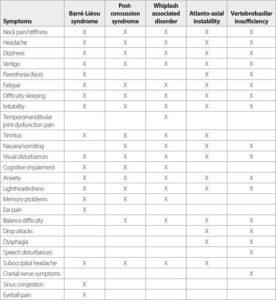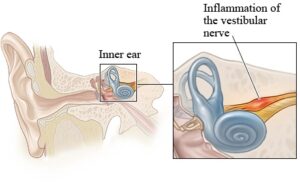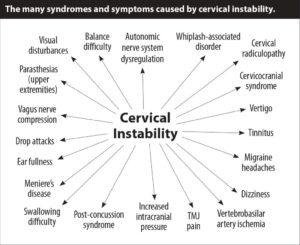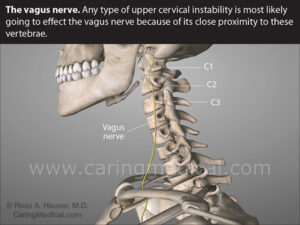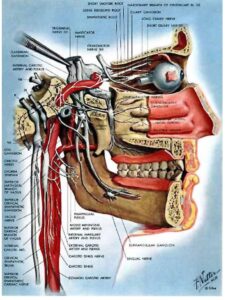First some about Barré-Lieou Syndrome complexity – a picture needed
Graphical network of the top 20 diseases related to Barre-Lieou Syndrome:
https://www.malacards.org/card/barre_lieou_syndrome &
Barre-Lieou – 20 dysfunctions associated
Unfortunately out of multidisciplinary perspective – see: ”Barré–Liéou syndrome is a traditional medical diagnosis that is not utilized frequently in modern medicine.[1] It is a complex combination of symptoms .. https://en.wikipedia.org/wiki/Barr%C3%A9%E2%80%93Li%C3%A9ou_syndrome
(Swedish – not all yet) below the English text)
But first/before something for me new (2024-11-07) giving some perpective and thoughts =
Cervicogenic Somatic Tinnitus: A Narrative Review Exploring Non-otologic Causes
”Cervicogenic somatic tinnitus (CST) is a subgroup of somatosensory tinnitus that arises from altered sensory input from the cervical spine due to changes in anatomical and physiological functions. Unlike primary tinnitus, usually caused by auditory system issues, CST is due to somatosensory disruptions from the cervical region. Conditions such as degenerative disc disease, cervical spondylosis, whiplash injuries, and neck muscle stress or spasms are commonly associated with CST. The pathophysiology of CST involves complex interactions between the cervical spine’s somatosensory inputs and central auditory pathways, particularly affecting the dorsal cochlear nucleus (DCN) in the brainstem, leading to enhanced excitability and synaptic reorganization, giving rise to tinnitus. Accurate diagnosis and management of CST require a comprehensive approach, including patient history, physical examination, audiological assessments, and imaging studies. Treatment strategies encompass physical therapy, medications, interventional procedures, and complementary therapies, aiming to reduce tinnitus perception, alleviate neck dysfunction, and improve overall quality of life. Emerging therapies, such as neuromodulation and regenerative medicine, show promise in further improving CST management. This multidisciplinary approach highlights the importance of addressing both musculoskeletal and auditory health in the effective treatment of CST.
https://pmc.ncbi.nlm.nih.gov/articles/PMC11346753/
Barre-Lieou syndrome: MedGen UID: 87688 Concept ID: C0376378 Disease or Syndrome
https://www.ncbi.nlm.nih.gov/medgen/87688
Symptoms: Headaches, tinnitus, cranial nerve dysfunction, hearing changes, vertigo, hoarsness, aphonia and decreased memory and concentration; Syndrome of Barre-Lieou
Definition: A neurologic syndrome following injury of the spinal sympathetic nerves of the neck. The injury usually results from arthritis or pinching by the adjacent vertebrae. Symptoms include facial pain, chronic allergies, dizziness, neck pain, ear pain and vertigo
Barre-Lieou Syntrome (Neck Pain, Blurred Vision, Nausea, Vertigo, Tinnitus)
https://piedmontpmr.com/diagnose-treat-barre-lieou-neck-pain-blurred-vision-nausea-vertigo-tinnitus-2/
The below is the same as the link above
1925-1928 “… dysfunction in the posterior cervical sympathetic nervous system (a group of nerves located near the vertebrae in the neck). The posterior cervical sympathetic syndrome became known as Barre-Lieou Syndrome.”
(Impossible picture at the link removed here – see more pictures readable below)
”Symptoms that characterize Barre-Lieou Syndrome include:
- headache
- neck, facial, ear and dental pain
- tinnitus
- vertigo (dizziness)
- nausea
- vomiting
- blurred vision
- tearing of the eyes
- sinus congestion
Other symptoms may include:
- swelling on one side of the face
- localized cyanosis (bluish color) of the face
- facial numbness
- hoarseness
- shoulder pain
- dysesthesias (pins and needles sensations) of the hands & forearms
- muscle weakness
- fatigue
How can one disorder cause all of these problems? The answer lies within the sympathetic nervous system (a portion of the autonomic nervous system) that monitors and regulates various activities that occur independently from the rest of the nervous system. Examples include pupil accommodation to light, equilibrium within the inner ear, and respiration.
If a structure that is innervated by (or being monitored by) the sympathetic system becomes injured, then it is the job of the sympathetic system to react to that injury. In the case of Barre-Leiou, the Posterior Cervical Sympathetic Chain forgets to stop monitoring the injury site; like a car engine that diesels, it forgets to shut down.
When this happens, the entire system becomes overly sensitive to any further stimulus. Shifting barometric pressure, stress, or sinus infections can make symptoms worse. Treatment should be directed toward restoring normal sympathetic nerve function, enhancing blood flow, and reducing total load (the total number of things that do not allow the system to heal).”
Diagnosis can be difficult, especially if the treating physician is not familiar with the disorder. Thermography is a specialized study that measures skin temperature.

It is an ideal test to evaluate for the presence of Barre-Lieou. More traditional studies include MRI (to rule out structural problems in the head and neck) and electrodiagnostic studies (to check for nerve damage).
Medications, physical therapy and sympathetic blocks (nerve blocks directed toward the sympathetic system) are all used to restore physiology to normal and relieve symptoms. People with persistent head and neck pain, such as after a motor vehicle accident, or with persistent migraine associated with blurred vision, numbness or tinnitus, should consider Barre-Lieou when looking for help.”
Cervical Instability as a Cause of Barré-Liéou Syndrome and Definitive Treatment with Prolotherapy: A Case Series
https://www.semanticscholar.org/paper/Cervical-Instability-as-a-Cause-of-Barr%C3%A9-Li%C3%A9ou-and-Hauser-Steilen/682d18a28d75c23c529f1a300cc5897f6dce1129
The results of eight patients from 2011 to 2013 who received prolotherapy for Barre-Lieou syndrome following longstanding symptoms after trauma are reported, and all patients reported improvement of neck pain and associated symptoms and increased physical activity.
Abstract
Barre-Lieou syndrome, or posterior cervical sympathetic syndrome, has symptomatology related to underlying cervical instability. While classified as a rare disease, Barre-Lieou syndrome is likely underdiagnosed. Vertebral instability, occurring after neck ligament injury, affects the function of cervical sympathetic ganglia (located anterior to vertebral bodies). Symptomatology includes neck pain, migraines/headache, vertigo, tinnitus, dizziness, visual/auditory disturbances, and other symptoms of the head/neck region. Treatment for Barre-Lieou syndrome is suboptimal and often involves long-term use of pain medications, chiropractic care, or surgical fusion. Prolotherapy offers a noninvasive treatment option to ameliorate symptoms while treating the underlying cause of the disorder—cervical instability. In this case series, the results of eight patients from 2011 to 2013 who received prolotherapy for Barre-Lieou syndrome following longstanding symptoms after trauma are reported. All patients reported improvement of neck pain and associated symptoms and increased physical activity. Prolotherapy should be considered as treatment for Barre-Lieou syndrome.
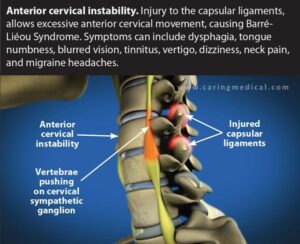
Figure 3. Capsular ligament laxity causes anterior cervical instability when the neck is flexed, resulting in impingement of the cervical sympathetic ganglion and producing symptoms of Barré-Liéou syndrome.
https://citeseerx.ist.psu.edu/document?repid=rep1&type=pdf&doi=bdee757bc826f7b8bd497a22b63357cf61eec8bd
Cervicocranial syndromes including Barré-Lieou Syndrome
https://www.caringmedical.com/prolotherapy-news/barre-lieou-cervicocranial-syndromes/
(NB text below is as at the link)
Cervicocranial syndrome can occur as a result of ligament weakness in the neck. Weakness of the neck ligaments commonly occurs because most people spend a good portion of their days looking down at phones and hunched over while working at their computers. Their work may consist of typing on a computer or being constantly tethered to their mobile devices for many hours per day, as well as the huge surge in computer gaming. Increasing amounts of patients have suffered from “text neck.” All of these tech activities precipitate the head-forward position and put the cervical vertebral ligaments in a stretched position. Over time, these ligaments weaken and cause pain (creep). The cervical spine ligament laxity causes an even more head-forward position, as the ligaments can no longer keep the cervical vertebrae in their proper posterior alignment. The paracervical muscles (the neck muscles) tighten to stabilize the joints and head. As the muscles tighten, they create more pain.
Eventually, the muscles can no longer stabilize the vertebrae and the ligaments are stretched even more. Neck pain increases and the cycle continues to repeat itself. Massage therapy, physical therapy, chiropractic/osteopathic manipulation, and pain medicines all help to temporarily relieve the pain. They do not, however, correct the underlying problem of ligament laxity.
What symptoms are produced in the face, head, and neck when the sympathetic nervous system is not working well in these areas? The primary symptom is a headache, since headaches are caused by dilation of blood vessels, as in cervicocranial syndrome.
Another symptom of cervicocranial syndrome is tinnitus (ringing in the ears). A decrease in sympathetic output to the inner ear will cause an accumulation of fluid in the inner ear. When fluid accumulates in the inner ear, as is often the case with an upper respiratory infection, the ear feels full and the body feels off balance. A ringing in the ear can occur, along with vertigo (dizziness).
The symptoms of Cervicocranial syndromes
- Chest pain
- Migraine headaches
- Clicking in the neck
- Neck pain
- Ear pain
- Recurrent disturbed vision
- Facial pain
- Severe fatigue
- Headache
- Sinus congestion
- Hoarseness
- Thinking impairment
- Light headedness
- Tinnitus
- Loss of voice
- Vertigo
- Memory problems
- Symptoms often increase with neck motion
Focus on my increasing development of balans problems, could be associcated with the dysfunction (probably related to dysfunction in OlivioCochlear (OC) in Pons but below as ”inflammation of the vestibular nerv ”Vestibular neuritis, is it contagious?
Skilled vestibular physiotherapists can assess the vestibular system and help arrive at an appropriate diagnosis, including whether you have vestibular neuritis.
Does vestibular neuritis show up on MRI?
No. The damage from vestibular neuritis occurs at the level of nerves and neural cells. MRI tests or CT scans do not have the resolution to show this level of detail.
https://cornerstonephysio.com/resources/what-is-vestibular-neuritis/#:~:text=Does%20vestibular%20neuritis%20show%20up,show%20this%20level%20of%20detail.
Cervico-orofacial syndromes
In September 2022, (1) researchers analyzed the neuroanatomical and neurophysiological (the structure and function of the nervous system) basis of cervicogenic pain in cervico-cranial pain syndromes. The researchers focused on cervico-orofacial syndromes. In reviewing previously published data, the researchers noted: “Despite abundant available experimental and clinical data, cervicogenic orofacial pain may be challenging to diagnose and treat. Crucial non-surgical therapeutic approach is the orthopedic manual therapy focused on correction of body posture, proper alignment of cervical vertebra and restoration of normal function of temporomandibular joint and occlusion.”
In many patients we see symptoms of TMJ are essentially the same as cervicocranial syndrome. It is our belief that the symptoms, such as dizziness, vertigo, etc., that physicians ascribe to TMJ. may in fact in many people are caused by cervicocranial syndrome / Barré-Lieou syndrome.
Barré-Liéou Syndrome
In September 2015, our researchers including Ross Hauser, MD and Danielle Steilen published our findings in the European Journal of Preventive Medicine on Cervical Instability as a Cause of Barré-Liéou Syndrome and Definitive Treatment with Prolotherapy: A Case Series.
This paper is summarized here:
Barré-Lieou syndrome was discovered by and named after Jean Alexandre Barre, M.D., a French neurologist, and Yong-Choen Lieou, a Chinese physician. Each discovered the syndrome independently and described a very wide range of symptoms thought to be due to a dysfunction of the group of nerves called the posterior cervical sympathetic nervous system, located near the vertebrae in the neck. Therefore, this condition is often better known as cervicocranial syndrome and posterior cervical sympathetic syndrome.
Barré-Liéou and Cervicocranial syndrome are due to cervical vertebral instability, which affects the function of the nerve cell aggregations located in the neck just in front of the vertebrae. Vertebral instability or misalignment occurs because the ligaments that support the neck become weakened or injured. This is what occurs in the commonly known whiplash injury. Not only do neck and headache pain occur with whiplash injury, but also the signs and symptoms of Barré-Lieou syndrome.
Barré-Liéou syndrome has symptoms related to underlying cervical instability. While classified as a rare disease, Barré-Liéou syndrome is likely underdiagnosed. Vertebral instability, occurring after neck ligament injury, affects the function of cervical sympathetic ganglia (nerve bundle).
Symptoms include neck pain and neck instability, migraines/headache, vertigo, tinnitus, dizziness, visual/auditory disturbances, and other symptoms of the head/neck region.
This condition also may develop in people who spend a good portion of their day hunched over while working. Any activity that precipitates the head forward position and puts the cervical vertebral ligaments in a stretched position will cause the ligaments to weaken over time. The ligament laxity causes an even more head forward position as the ligaments can no longer keep the cervical vertebrae in their proper posterior alignment. Neck pain results and the cycle repeats itself.
Treatment for Barré-Liéou syndrome is suboptimal and often involves long-term use of pain medications, chiropractic care, or surgical fusion.
Trazodone (anti-depressant) treatment for Barré-Lièou syndrome
In May 2021, doctors writing in the journal Drug discoveries & therapeutics (3) retrospectively examined the effectiveness of trazodone (TZD) for treating Barré-Lièou syndrome in 20 patients. The researchers found Trazodone could effectively and safely treat Barré-Lièou syndrome, and early diagnosis and treatment can contribute toward good clinical outcomes.
Prolotherapy offers a noninvasive treatment option to relieve symptoms while treating the underlying cause of the disorder—cervical instability.
Cervical Instability as a Cause of Barré-Liéou Syndrome and Definitive Treatment with Prolotherapy: A Case Series
Abstract: Barré-Liéou syndrome, or posterior cervical sympathetic syndrome, has symptomatology related to underlying cervical instability. While classified as a rare disease, Barré-Liéou syndrome is likely underdiagnosed. Vertebral instability, occurring after neck ligament injury, affects the function of cervical sympathetic ganglia (located anterior to vertebral bodies). Symptomatology includes neck pain, migraines/headache, vertigo, tinnitus, dizziness, visual/auditory disturbances, and other symptoms of the head/neck region. Treatment for Barré-Liéou syndrome is suboptimal and often involves long-term use of pain medications, chiropractic care, or surgical fusion. Prolotherapy offers a noninvasive treatment option to ameliorate symptoms while treating the underlying cause of the disorder—cervical instability. In this case series, the results of eight patients from 2011 to 2013 who received prolotherapy for Barré-Liéou syndrome following longstanding symptoms after trauma are reported. All patients reported improvement of neck pain and associated symptoms and increased physical activity. Prolotherapy should be considered as treatment for Barré-Liéou syndrome.
Pictures:
https://www.caringmedical.com/prolotherapy-news/vagus-nerve-compression-cervical-spine/

https://www.semanticscholar.org/paper/Cervical-Instability-as-a-Cause-of-Barr%C3%A9-Li%C3%A9ou-and-Hauser-Steilen/682d18a28d75c23c529f1a300cc5897f6dce1129/figure/4
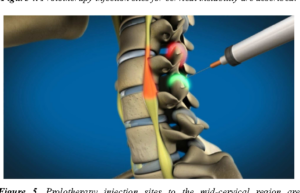
Figure 3. Capsular ligament laxity causes anterior cervical instability when the neck is flexed, resulting in impingement of the cervical sympathetic ganglion and producing symptoms of Barré-Liéou syndrome.
CERVICAL INSTABILITY: THE MISSING LINK IN MOST PAINFUL NECK CONDITIONS
Tinnitus, cervical spine instability, and neck pain – Caring Medical Florida – https://goodmoocsk.life/product_details/10368564.html
Table = Barre-Lieou – Syndrome comparison —
https://article.sciencepublishinggroup.com/html/10.11648.j.ejpm.20150305.15.html
More links:
https://en.wikipedia.org/wiki/Barr%C3%A9%E2%80%93Li%C3%A9ou_syndrome
https://www.caringmedical.com/wp-content/uploads/2018/06/Cervical-Instability-EJPM.pdf
https://www.miracle-ear.com/hearing-diseases/tinnitus-ringing-ears/cervical-tinnitus
https://jnnp.bmj.com/content/75/2/319
https://pubmed.ncbi.nlm.nih.gov/31534077/
https://pubmed.ncbi.nlm.nih.gov/17052362/
https://www.medserena.co.uk/mri-scans/spine-and-ccj/craniocervical-junction-mri-scan
https://www.google.com/url?sa=t&rct=j&q=&esrc=s&source=web&cd=&ved=2ahUKEwjBmpbGntKBAxUtSPEDHYH3BoEQFnoECC4QAQ&url=https%3A%2F%2Fwww.sbshospital.com%2Fcervicocranial-syndrome%2F&usg=AOvVaw32G2eVoRfBe5mOYMWNmh78&opi=89978449
https://www.patientslikeme.com/conditions/barre-lieou-syndrome
https://forums.phoenixrising.me/threads/cfs-subgroup-barre-lieou-syndrome.30932/
https://menieres.org/forum/threads/barre-lieou-anyone-know-about-this-syndrome.11597/
Or – am I on wrong trace?
See e.g.
Silencing middle ear myoclonus (Part one) https://www.topdoctors.co.uk/medical-articles/silencing-middle-ear-myoclonus-part-one The inner-ear noises that people with middle ear myoclonus (MEM) experience can be so severe that they’re unable to sleep. Learning to live with the symptoms may not be practical for those with such debilitating effects, so what can be done to solve the problem?
In the first part of a double series of articles, one of the UK’s leading otologists, Professor Manohar Bance, provides a comprehensive answer to this question. He discusses the ins and outs of middle ear myoclonus in expert detail.
In part two, you can find out more about diagnosis, treatment and management of middle ear myoclonus.
Silencing middle ear myoclonus (Part two) – How is it diagnosed? https://www.topdoctors.co.uk/medical-articles/silencing-middle-ear-myoclonus-part-two
Primarily this middle ear myoclonus is diagnosed by the patient’s typical history. Sometimes the sounds can be heard as well by the examiner, and sometimes the contractions can be recorded on a tympanometer. A tympanometer is an instrument that audiologists use to measure middle ear pressure, but can record sound from ear canal as well. Normally, we would test you with a variety of different triggers to see if they caused clicking sounds, and also exclude palatal myoclonus by examining the back of your throat with a fibreoptic camera.
-> No more is to come here, if a well-grounded new trace emerge, it will be at a new tab.
Swedish (maskin översättning – tyvärr ej ännu av allt ovan!)
Barre-Lieous syndrom: MedGen UID: 87688 Begrepps-ID: C0376378 sjukdom eller syndrom
https://www.ncbi.nlm.nih.gov/medgen/87688
Symptom: Huvudvärk, tinnitus, kranialnerv dysfunktion, hörselförändringar, svindel, heshet, aphonia och minskat minne och koncentration; Syndrom av Barre-Lieou
Definition: Ett neurologiskt syndrom efter skada på ryggmärgens sympatiska nerver. Skadan beror vanligtvis på artrit eller klämning av de intilliggande ryggkotorna. Symtomen inkluderar ansiktssmärta, kroniska allergier, yrsel, nacksmärta, öronsmärta och svindel
Nedanstående är samma som länken ovan
1925-1928
”… dysfunktion i det bakre cervikala sympatiska nervsystemet (en grupp nerver som ligger nära ryggkotorna i nacken). Det bakre cervikala sympatiska syndromet blev känt som Barre-Lieous syndrom.”
”Symtom som kännetecknar Barre-Lieous syndrom inkluderar:
huvudvärk
smärta i nacke, ansikte, öron och tandvård
tinnitus
Vertigo (yrsel)
Illamående
kräkning
suddig syn
tårar i ögonen
täppta bihålor
Andra symtom kan inkludera:
svullnad på ena sidan av ansiktet
lokaliserad cyanos (blåaktig färg) i ansiktet
domningar i ansiktet
heshet
Smärta i axlarna
dysestesier (myrkrypningar, förnimmelser) i händer och underarmar;
muskelsvaghet
trötthet
Hur kan en störning orsaka alla dessa problem? Svaret ligger inom det sympatiska nervsystemet (en del av det autonoma nervsystemet) som övervakar och reglerar olika aktiviteter som sker oberoende av resten av nervsystemet. Exempel är pupillanpassning till ljus, jämvikt i innerörat och andning.
Om en struktur som innerveras av (eller övervakas av) det sympatiska systemet skadas, är det det sympatiska systemets uppgift att reagera på den skadan. När det gäller Barre-Leiou glömmer den bakre cervikala sympatiska kedjan att sluta övervaka skadestället; Som en bilmotor som dieslar, glömmer den att stänga av.
När detta händer blir hela systemet alltför känsligt för ytterligare stimulans. Skiftande barometertryck, stress eller sinusinfektioner kan förvärra symtomen. Behandlingen bör inriktas på att återställa normal sympatisk nervfunktion, förbättra blodflödet och minska den totala belastningen (det totala antalet saker som inte tillåter systemet att läka).
Diagnos kan vara svårt, särskilt om den behandlande läkaren inte är bekant med sjukdomen. Termografi är en specialiserad studie som mäter hudtemperaturen. Det är ett idealiskt test att utvärdera för närvaron av Barre-Lieou. Mer traditionella studier inkluderar MR (för att utesluta strukturella problem i huvud och nacke) och elektrodiagnostiska studier (för att kontrollera nervskador).
Mediciner, sjukgymnastik och sympatiska block (nervblock riktade mot det sympatiska systemet) används alla för att återställa fysiologin till det normala och lindra symtomen. Personer med ihållande huvud- och nacksmärta, till exempel efter en motorfordonsolycka, eller med ihållande migrän i samband med dimsyn, domningar eller tinnitus, bör överväga Barre-Lieou när de söker hjälp.”
Cervikokraniella syndrom inklusive Barré-Lieous syndrom
https://www.caringmedical.com/prolotherapy-news/barre-lieou-cervicocranial-syndromes/
(OBS texten nedan är samma som på länken)
Cervikokraniellt syndrom kan uppstå som ett resultat av ligamentsvaghet i nacken. Svaghet i nackligamenten uppstår vanligtvis eftersom de flesta människor tillbringar en stor del av sina dagar tittar ner på telefoner och böjda över medan de arbetar vid sina datorer. Deras arbete kan bestå av att skriva på en dator eller ständigt vara bunden till sina mobila enheter i många timmar per dag, liksom den enorma ökningen av datorspel. Allt fler patienter har drabbats av ”texthals”. Alla dessa tekniska aktiviteter fäller ut huvud-framåt-positionen och sätter livmoderhalsens ligament i ett sträckt läge. Med tiden försvagas dessa ligament och orsakar smärta (krypning). Den cervicala ryggraden ligament slapphet orsakar en ännu mer framåtriktad position, eftersom ligamenten inte längre kan hålla livmoderhalsen i sin rätta bakre inriktning. De paracervikala musklerna (nackmusklerna) stramar för att stabilisera lederna och huvudet. När musklerna stramar skapar de mer smärta.
Så småningom kan musklerna inte längre stabilisera ryggkotorna och ligamenten sträcks ännu mer. Nacksmärta ökar och cykeln fortsätter att upprepa sig. Massage, sjukgymnastik, kiropraktik / osteopatisk manipulation och smärtstillande läkemedel hjälper alla till att tillfälligt lindra smärtan. De korrigerar dock inte det underliggande problemet med ligamentslapphet.
Vilka symtom produceras i ansikte, huvud och nacke när det sympatiska nervsystemet inte fungerar bra i dessa områden? Det primära symptomet är huvudvärk, eftersom huvudvärk orsakas av utvidgning av blodkärl, som i cervikokraniellt syndrom.
Ett annat symptom på cervikokraniellt syndrom är tinnitus (ringningar i öronen). En minskning av sympatisk utgång till innerörat kommer att orsaka ansamling av vätska i innerörat. När vätska ackumuleras i innerörat, vilket ofta är fallet med en övre luftvägsinfektion, känns örat fullt och kroppen känns ur balans. En ringning i örat kan uppstå, tillsammans med svindel (yrsel).
Symptomen på Cervikokraniella syndrom
•Bröstsmärta
• Migrän huvudvärk
• Klicka i nacken
• Nacksmärta
• Ont i örat
• Återkommande synstörningar
• Smärta i ansiktet
• Svår trötthet
•Huvudvärk
• Täppta bihålor
•Heshet
• Tankenedsättning
• Yrsel
•Tinnitus
• Förlust av röst
•Yrsel
• Minnesproblem
• Symtomen ökar ofta med nackrörelse
Cervico-orofacial syndrom
I september 2022 analyserade (1) forskare den neuroanatomiska och neurofysiologiska (nervsystemets struktur och funktion) grunden för cervikogen smärta vid cervico-kraniala smärtsyndrom. Forskarna fokuserade på cervico-orofacial syndrom. Vid granskning av tidigare publicerade data noterade forskarna: ”Trots rikliga tillgängliga experimentella och kliniska data kan cervikogen orofacial smärta vara utmanande att diagnostisera och behandla. Avgörande icke-kirurgisk terapeutisk metod är den ortopediska manuella terapin fokuserad på korrigering av kroppshållning, korrekt inriktning av livmoderhalsen och återställande av normal funktion av temporomandibulär led och ocklusion.
Hos många patienter ser vi att symtom på TMJ i huvudsak är desamma som cervikokraniellt syndrom. Det är vår övertygelse att symtomen, såsom yrsel, svindel, etc., som läkare tillskriver TMJ. kan faktiskt hos många människor orsakas av cervikokranialt syndrom / Barré-Lieous syndrom.
Barré-Liéous syndrom
I september 2015 publicerade våra forskare, inklusive Ross Hauser, MD och Danielle Steilen våra resultat i European Journal of Preventive Medicine om cervikal instabilitet som orsak till Barré-Liéou syndrom och definitiv behandling med proloterapi: En fallserie.
Detta dokument sammanfattas här:
Barré-Lieous syndrom upptäcktes av och namngavs efter Jean Alexandre Barre, M.D., en fransk neurolog, och Yong-Choen Lieou, en kinesisk läkare. Var och en upptäckte syndromet oberoende och beskrev ett mycket brett spektrum av symtom som tros bero på en dysfunktion i gruppen av nerver som kallas det bakre cervikala sympatiska nervsystemet, som ligger nära ryggkotorna i nacken. Därför är detta tillstånd ofta bättre känt som cervikokraniellt syndrom och bakre cervikalt sympatiskt syndrom.
Barré-Liéou och Cervikokraniellt syndrom beror på cervikal vertebral instabilitet, vilket påverkar funktionen hos nervcellsaggregationerna som ligger i nacken precis framför ryggkotorna. Vertebral instabilitet eller felinriktning uppstår eftersom ligamenten som stöder nacken blir försvagade eller skadade. Detta är vad som händer vid den allmänt kända whiplashskadan. Inte bara nacke och huvudvärk smärta uppstår med whiplash skada, men också tecken och symtom på Barré-Lieou syndrom.
Barré-Liéous syndrom har symtom relaterade till underliggande cervikal instabilitet. Medan klassificeras som en sällsynt sjukdom, är Barré-Liéou syndrom sannolikt underdiagnostiserad. Vertebral instabilitet, som uppstår efter nackligamentskada, påverkar funktionen av cervikala sympatiska ganglier (nervbunt).
Symtomen inkluderar nacksmärta och nackinstabilitet, migrän / huvudvärk, svindel, tinnitus, yrsel, visuella / auditiva störningar och andra symtom i huvud / nackregionen.
Detta tillstånd kan också utvecklas hos personer som tillbringar en stor del av sin dag böjda över medan de arbetar. Varje aktivitet som fäller huvudet framåt och sätter livmoderhalsen i ett sträckt läge kommer att få ligamenten att försvagas över tiden. Ligamentslappheten orsakar en ännu mer framåtriktad position eftersom ligamenten inte längre kan hålla halskotorna i sin rätta bakre inriktning. Nacksmärta resulterar och cykeln upprepar sig.
Behandling för Barré-Liéous syndrom är suboptimal och innebär ofta långvarig användning av smärtstillande medel, kiropraktisk vård eller kirurgisk fusion.
Trazodon (antidepressiva) behandling för Barré-Lièous syndrom
I maj 2021 undersökte läkare som skrev i tidskriften Drug discoveries & therapeutics (3) retrospektivt effektiviteten av trazodon (TZD) för behandling av Barré-Lièous syndrom hos 20 patienter. Forskarna fann att Trazodon effektivt och säkert kunde behandla Barré-Lièous syndrom, och tidig diagnos och behandling kan bidra till goda kliniska resultat.
Proloterapi erbjuder ett icke-invasivt behandlingsalternativ för att lindra symtomen vid behandling av den bakomliggande orsaken till sjukdomen – cervikal instabilitet.

